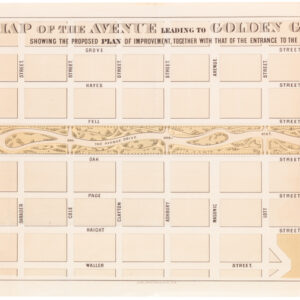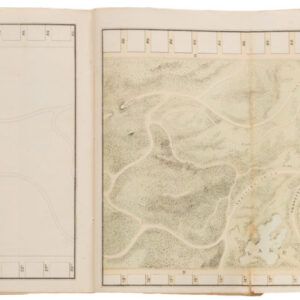An extraordinary collection of late 19th-century photographs from America’s West Coast.
[Seventeen original Taber albumen photographs of California and Oregon]
$1,500
In stock
Description
A wonderful collection of albumen photographs, including cabinet cards and relatively larger photographs, produced by Isaiah West Taber in the late 19th century. Subjects mostly consist of well-known sites in and around San Francisco, with others ranging as far as Oregon and the San Gabriel Valley near Los Angeles. Together, they provide an excellent snapshot of the development of the American West, from gold seekers and gunslingers to something more durable, in the late 19th century.
Below are the titles of photographs included with some explanatory details:
- “Fort Point 1608” Note the cannons partially extending beyond the line of the wall towards the left. The fort was designed to allow for cannons to be placed as close to sea level as possible so that cannonballs could be ricocheted along the top of the water towards enemy vessels.
- “1902 Fort Point.” A crowd gathered on the fort’s roof, and smoke on the far side indicates a demonstration or target practice of the fort’s cannons. 1902 may refer to the year or a classification code used by Taber.
- “Hotel Del Monte front view from garden—Monterey, Cal.” Perhaps the most famous hotel in California at the time. Also held by the University of California Berkeley’s Bancroft Library in the “Album of Views of California and the West, Canada, and China” (BANC PIC 1999.055–fALB).
- “Court Yard from the South. Leland Stanford Jr. University. Palo Alto, Cal.” A similar view of the same courtyard from the north is held by the Bancroft Library (BANC PIC 1985.031:130–ALB).
- “The Loops, looking East.” Also known as the “Double Bow Knot,” a famous portion of the Mount Tamalpais and Muir Woods Railway, opened 1896. The only other known example is held by the Bancroft Library (BANC PIC 1985.031:74–ALB).
- Untitled. [Court, Palace Hotel, S.F., Cal]. Despite displaying the same angle and likely being taken on the same day, this photograph differs from the example held by the Library of Congress, OCLC 925597116, and the San Francisco Public Library (http://hdl.handle.net/20.500.12352/islandora:161225), as well as other untitled contemporaneous Taber photographs of the same courtyard, such as the example held by the University of California Berkeley Bancroft Library’s “Views from a trip to California” collection, OCLC 34368662.
- “Opposite Palace and Grand Hotels, San Francisco, Cal.” [Charles Crocker Mansion] Aside from its size and opulence, Crocker’s mansion was famous at the time for its impact on a neighboring property. In the 1870s, Crocker and his business partners had built a cable car up California Street and purchased much of the surrounding land. But when Nicholas Yung refused to sell his lot and relatively modest cottage, Crocker built a 40 foot tall ‘spite fence’ around Yung’s property. The dispute became symbolic of deep class divisions in San Francisco’s society, with the raucous Workingmen’s Party of California holding a protest in front of Crocker’s mansion condemning the fence. Even after Yung moved out, and both he and Crocker died, the fight continued, with Yung’s family refusing to sell until Yung’s widow died in 1902. Not long after, the 1906 earthquake and fire destroyed both houses and the entire neighborhood. Afterwards, the land was donated to the Episcopal Church and used to construct the magnificent Grace Cathedral.
- “Panorama of San Francisco.” Location unknown, but likely looks westwards up Russian Hill from the direction of North Beach. Also cataloged in the “Western views photograph album” at the Utah State University Merrill-Cazier Library’ Special Collections and Archives Division (Collection number UUS_P0205).
- “Arizona Garden, “Hotel del Monte,” Monterey. Inspired by Carleton Watkins, if not one of his originals (see Taber’s biography below).
- “Seal Rock, Pacific Ocean.” Held by the California State Library ((C)001394136CSL01-Aleph) and the Bancroft Library (Inventory of Taber and Jackson Miscellany [graphic], ca. 1890; BANC PIC 19xx.113–AX).
- “Arches on Cliff Road, Santa Cruz.” Only cataloged among the holdings of the Bancroft Library (BANC PIC 1985.031:117–ALB).
- “10th Crossing, S.P. [Southern Pacific] Co. Oregon Division.” Only cataloged among the holdings of Stanford University (I.W. Taber photographs, MSS.PHOTO.0175).
- “U.S. Coast Defense S.S. Monterey, December 28th 1892.” No other known examples, though the California State Library holds a Taber image of the same ship from 1895, in the album “Atlanta Exposition, Pacific Coast views” (Picture Collection F869 S3 T22 1895), in which its main guns have been replaced by more modern double-barreled guns.
- “An Orange Grove, San Gabriel Valley, California.” Known examples held by the Huntington Library (Item 19 in “Miscellaneous California photographs,” photCL 113, perhaps a different image with the same title) and the University of Maryland Baltimore County (Call Number P75-04-042, Lossing Box 14).
- “Oceanic S.S. Co’s Steamer ‘Mariposa.’ H.m. Hayward, Commander.” One of at least two photographs taken of the ship by Taber, which were often incorporated into advertisements and broadsides.
- “Palace Hotel, San Francisco, Cal.” A fine view of the ‘old’ Palace Hotel built by William Chapman Ralston, who was financially ruined by the project, and which was destroyed in the 1906 earthquake and fire. It was the tallest building in San Francisco when opened in 1875. The photograph is notable for displaying a skyway across New Montgomery Street at left.
- “Big Trees, Felton, Santa Cruz Co.” Several photographs with this title exist but different classification numbers (this as B 1719). All appear to be Carleton Watkins originals sold by Taber. This particular photograph is cataloged among the holdings of the Bancroft Library (BANC PIC 1985.031:119–ALB).
Cartographer(s):
Isaiah West Taber (August 17, 1830 – February 22, 1912), often as I. W. Taber, was an innovative photographer who produced early photographs of San Francisco, where he was based, and other points in California and throughout the American West. Born in Massachusetts, Taber moved to California in 1850 before returning east in 1854 and opening a photography studio in Syracuse, New York. In 1864, he returned to California to work at Bradley & Rulofson (that is, William Rulofson and Henry William Bradley), the leading photographic studio in San Francisco and on the West Coast.
Taber opened his own studio in 1871, finding success by reproducing images from Carleton Watkins’ bankrupted Yosemite Art Gallery without attribution. Taber’s original photographs of California, other places on the West Coast, and Hawaii were also popular, and he established himself as a leading photographer in the city. However, like Carleton Watkins, Taber’s studio and the entire collection of negatives were destroyed in the 1906 San Francisco earthquake and fire, effectively ending his career.
Condition Description
Very good or better. Either printed on card stock or on thin photographer paper and then pasted to backing of varying thicknesses.
References




![Inside [San Francisco]](https://neatlinemaps.com/wp-content/uploads/2019/11/NL-00737-scaled-300x300.jpg)
